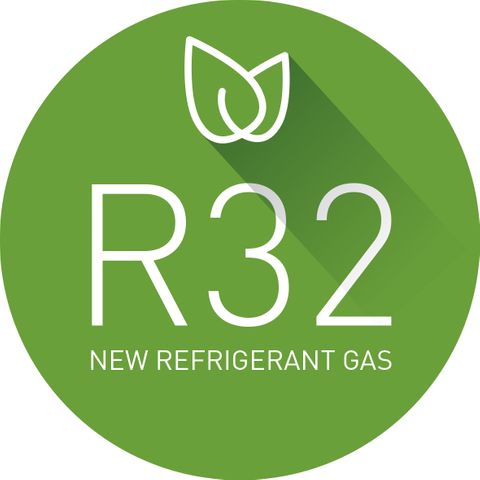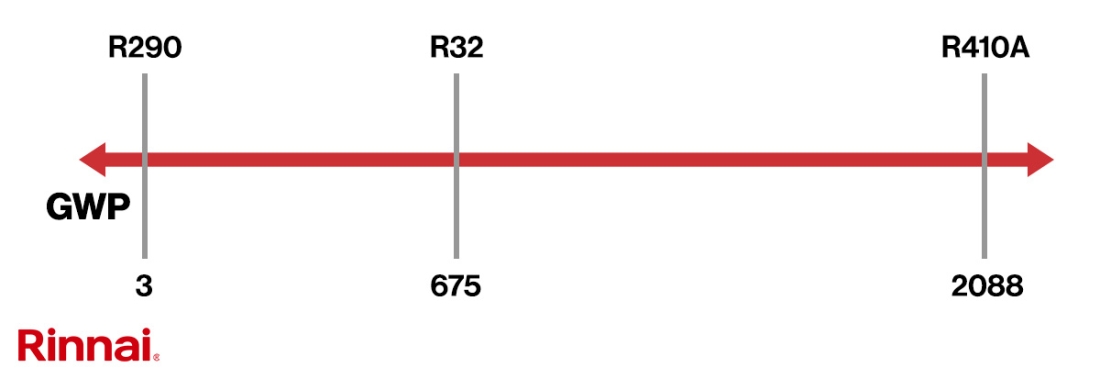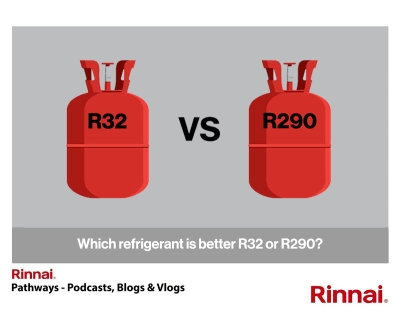At a time where environmental responsibility and regulations are driving innovation, eco-friendly refrigerants are increasingly finding their place within HVAC systems such as heat pumps. Regulations such as F-gas will require the heat pump industry to transition to refrigerants with lower GWP which align with EU climate targets.
This often leads to the question of which refrigerant is better R32 or R290? Below we will look into an overview of both refrigerants from a performance, environmental impact and cost perspective.
Join our newsletter today and don’t miss out of the latest heat pump news and regulations.
An overview of R32 Refrigerant

When compared to its predecessor R32 is a more environmentally friendly refrigerant, as it potentially contributes much less to global warming. R32 is a highly energy efficient refrigerant and is therefore an appealing option for commercial air conditioning and heat pump projects.
R32 can operate at a higher pressure than some other refrigerants, which can result in more efficient heat transfer. R32 also has a low boiling point, which permits effective cooling even in high-temperature environments. The mixture of these properties indicates that R32 can help systems achieve optimal performance with reduced energy usage, aligning with the growing demand for sustainable and eco-friendly technologies.
Overview of R290 Refrigerant
R290 or propane, is a natural hydrocarbon refrigerant. As a natural substance, R290 offers greater environmental benefits than R32, largely due to its really low global warming potential (GWP) and zero ozone depletion potential (ODP). The GWP for R290 is 3, R290 is one of the most eco-friendly refrigerants available for heat pump systems. Furthermore, R290's chemical makeup is free of chlorine and fluorine, meaning that it does not contribute to ozone depletion.
R290 is also renowned for its high energy efficiency. R290 has excellent thermodynamic properties, which include high latent heat of vaporisation, allowing for highly efficient heat transfer. This results in lower energy consumption which translates to potential cost savings.
Despite its advantages, R290 does come with some challenges. As a R290 is a hydrocarbon refrigerant, it is highly flammable, which equals careful handling and transportation along with strict safety measures during installation and maintenance.
Environmental Benefits of R32

R32's basic environmental friendliness is in its lower global warming potential (GWP) compared to traditional refrigerants. With a GWP of 675, R32 has far less potential impact on the environment than older refrigerants such as R410A (GWP of 2088).
Additional environmental advantages of R32 lie within its energy efficiency. R32's thermodynamic properties allow for a more efficient heat transfer and cooling performance, which translates to lower energy consumption. This increased efficiency reduces operating costs which in turn reduces carbon emissions from the grid.
Environmental Benefits of R290
R290, or propane, stands out as one of the most environmentally friendly refrigerants available, primarily due to its extremely low global warming potential (GWP) and zero ozone depletion potential (ODP). With a GWP of just 3, R290 has a negligible impact on global warming compared to synthetic refrigerants. Moreover, R290's zero ODP means that it cannot harm the ozone layer, further enhancing its environmental credentials.
Unlike synthetic refrigerants, which are chemically fabricated, R290 is a naturally occurring hydrocarbon meaning that it can be sourced sustainably and does not introduce the potential of harmful chemicals into the environment.
Furthermore, R290's has excellent thermodynamic properties allowing for efficient heat transfer and cooling, which creates lower energy consumption. This efficiency translates to reduced greenhouse gas emissions upstream power generation sources, as less energy is required to achieve the desired heating and cooling effect.
Energy Efficiency Comparison: R32 vs R290
When comparing the energy efficiency of R32 and R290, it is essential to consider their thermodynamic properties and performance in various applications. R32 is known for its high energy efficiency, which is attributed to its favourable thermodynamic characteristics. It operates at higher pressures, resulting in more efficient heat transfer and cooling performance. This efficiency is particularly advantageous in HVAC systems, where R32 can help reduce energy consumption and operating costs.
R290 also boasts excellent energy efficiency due to its high latent heat of vaporisation and effective heat transfer properties. R290's natural thermodynamic advantages make it an efficient refrigerant for both residential and commercial applications. In particular, R290 is well-suited for use in refrigeration systems and commercial heat pump systems where its efficiency can lead to significant energy savings. The lower energy consumption associated with R290 further enhances its environmental benefits, as it reduces the overall demand for electricity and associated greenhouse gas emissions. The combination of natural properties and energy efficiency makes R290 a compelling option for eco-friendly refrigeration.
Don’t miss out and request a free brochure on Rinnai R290 heat pumps today https://www.rinnai-uk.co.uk/contact-us/request-brochure
The choice between R32 and R290 ultimately depends on the specific application and performance requirements, practical and economic feasibility. For design support or system advice, contact us today.
Safety Considerations for R32 and R290
Safety is a fundamental factor when evaluating refrigerants, especially those used in residential and commercial applications. R32, while offering numerous environmental and efficiency benefits, is classified as mildly flammable under certain policies and industry bodies. This means that while R32 is less flammable than some other refrigerants, it still requires careful handling and safety measures during installation and operation. Like with all systems, proper ventilation, leak detection systems, and adherence to safety protocols are essential to ensure the safe use of refrigerants like R32 in HVAC systems.
R290 presents more significant challenges due to its classification as a highly flammable refrigerant. The flammability of R290 necessitates safety measures to prevent accidents and ensure safe operation. This includes the use of leak detection systems, and proper ventilation in areas where R290 is used. Additionally, engineers working with R290 must be trained in handling flammable refrigerants and aware of the specific safety procedures required for installation, maintenance, and disposal.
It is essential for manufacturers, installers, and consumers to be aware of these safety considerations and to implement the necessary precautions. By doing so, the benefits of R32 and R290 can be realised without compromising safety, ensuring that these eco-friendly refrigerants can be used effectively and responsibly.
Cost Analysis: R32 vs R290
Cost is a critical consideration as it directly impacts both capital investment and operational expenditure. R32 is often considered a cost-effective option due to its high energy efficiency, which can lead to significant savings on operating costs over time. The initial cost of R32-compatible equipment may be slightly higher than traditional systems, but the reduced energy consumption and lower GWP can result in long-term financial benefits.
R290, while also offering excellent energy efficiency often presents a higher capital cost due to higher equipment costs. However, the long-term energy savings achieved through the use of R290 can offset these initial expenses. In commercial and industrial applications, where energy consumption is high, the efficiency of R290 can lead to substantial cost savings over the lifespan of the equipment.
When conducting a cost analysis of R32 versus R290, it is essential to consider both the upfront investment and operational costs over the system’s lifetime. While R32 may offer a more straightforward and cost-effective solution for many applications, R290's high energy efficiency and minimal environmental impact can provide significant financial benefits in the long run. The choice between R32 and R290 ultimately depends on the specific needs and priorities of the user, including budget constraints, environmental goals, and safety requirements. R290 is also much better suited to the future goals of UK and EU legislation in terms of low-GWP refrigerants.
For a free system assessment that analyses the capital expenditure, operational expenditure and carbon modelling, contact our design team today.
Conclusion: Which Refrigerant is the Future?
Both R32 and R290 refrigerants offer significant advantages in terms of environmental impact, energy efficiency, and performance when compared to traditional refrigerants. In the UK, the choice between R32 and R290 ultimately depends on the specific application, performance requirements, and safety considerations.
R32 is known for its higher energy efficiency and lower global warming potential, making it a popular choice for residential and commercial air conditioning systems. On the other hand, R290, being a natural refrigerant, is highly favoured for its minimal environmental impact and excellent thermodynamic properties, making it suitable for various industrial applications.
Therefore, the decision between R32 and R290 should be based on the specific needs and regulations within the UK market. Future regulations as mentioned such as the F-Gas Regulation (EC517/2014) aims to reduce the use of high Global Warming Potential (GWP) gases, including R32, by limiting the amount of gas that can be placed on the market.
This regulation will further encourage the adoption of low-GWP and natural refrigerants like R290.
